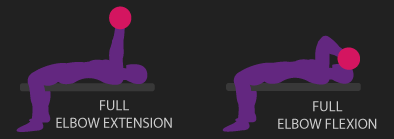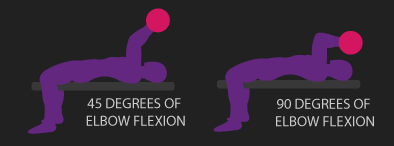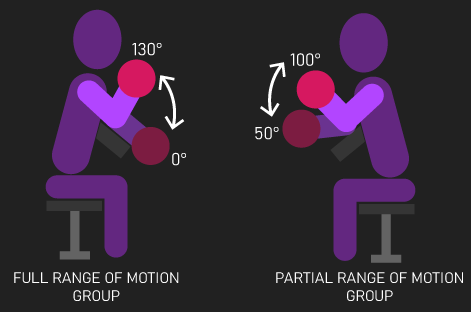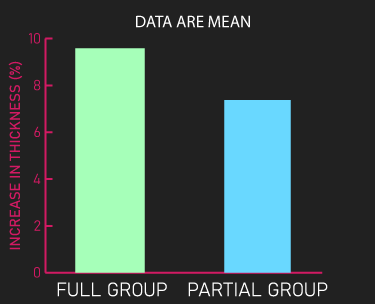
In the bodybuilding world, it’s not uncommon to see a constant tension technique being used.
Typically, this is done by avoiding locking out the joints in an exercise, resulting in the muscle producing continuous tension for the full duration of a set.

It’s hypothesized that compared to locking out the joints in an exercise and allowing the muscles to briefly rest, keeping constant tension on the muscle is a more powerful stimulus.
Preventing the muscle from “breathing”, so to speak, can decrease the oxygen content in muscles and result in the build of metabolites.
Although it’s far from crystal clear, some research indicates these events may play some role in muscle hypertrophy.
So, what does the research say, can constant tension enhance muscle growth?
Research on Constant Tension
A Partial Range of Motion That Uses a Constant Tension
A study by Goto et al. does suggest that constant tension builds more muscle.
44 men with at least 1 year of training experience were assigned to a partial or full group.
Both groups trained the triceps skull crusher.
The full group began with their elbows in full extension, lowering the weight to their maximal elbow flexion angle and then extending back to full extension.

The partial group performed the exercise from 45 to 90 degrees of elbow flexion, meaning it was a partial range of motion that kept constant tension on the triceps.

Both groups trained with 3 sets of 8 reps (with an 8-rep max load relative to their range of motion), three times per week for 8 weeks.
Increases in triceps cross-sectional area (measured at 60% of the upper arm length) was significantly greater for the partial group.

For the partial group, the researchers also measured the degree of hypoxia experienced by the subjects after performing the constant tension skull crushers.
In this case, hypoxia refers to a decrease in muscle oxygen levels.
Interestingly, the researchers found a correlation between the degree of hypoxia experienced by subjects and their increase in triceps cross-sectional area.

Put differently, the subjects in the partial group that experienced the highest decrease in muscle oxygen levels, also experienced the greatest increases in triceps cross-sectional area.
Now, correlation does not prove causation.
But maybe this study suggests a constant tension can enhance muscle growth by creating greater muscle hypoxia.
However, this is only one study. How does it compare with the rest of the constant tension research?
Pinto et al. had a comparable study design to the Goto et al. study.
30 untrained men were assigned to a partial or full group.
Both groups trained the preacher curl for around 2-4 sets with 8-20 reps, twice per week for 10 weeks.
The full group performed the exercise from 0 to 130 degrees of elbow flexion (more or less a full range of motion).
The partial group performed the exercise from 50 to 100 degrees of elbow flexion, meaning it was a partial range of motion that kept constant tension on the biceps.

Increases in biceps thickness favored the full group.

So, this study suggests a full range of motion is superior to a partial range of motion that applies constant tension.
Therefore, this study somewhat directly conflicts with the Goto et al. study.
So, collectively, these two studies cannot provide us with a clear view of the effectiveness of a partial range of motion that applies constant tension.
There actually is another study that used a constant tension technique through a partial range of motion, but I’ll detail this towards the end of the article.
Before moving on, if you’re curious about creating an effective training program for muscle hypertrophy, our high quality partner Alpha Progression can help. It can generate a highly effective program for you, track your workouts live with in-built progression recommendations, provide graphs displaying your long term progress, and it has a massive exercise database with more than 550 exercises.
Click HERE (the link opens in a new tab) to get a free 2 week trial of the apps features. If you like it and go beyond, the link also gives you 20% off a subscription!
We never promote trash at the House of Hypertrophy, so rest assured the app is high quality. The reviews speak to this, 4.8 starts (based on more than 7,000 reviews) on Google play, and 4.9 stars in Apple’s store (based on nearly 400 ratings).
Constant Tension That Does Not Significantly Reduce Range of Motion
Moving on, although the studies by Goto and Pinto did use a constant tension, they did so by significantly reducing the range of motion.
It is possible to use a constant tension without significantly reducing the range of motion.
A study by Tanimoto et al. explored the effectiveness of doing just this.
16 untrained men were assigned to constant tension or normal group.
Both groups trained the same 5 exercises: machine squat, chest press, lat pulldown, abdominal crunch, and back extension. Each for 3 sets of repetitions to failure each session.
The normal group performed each exercise with a full range of motion, using an 85-90% one-rep max load and a 1-second lifting, 1-second lowering, and 1-second pause phase.
The pause phase enabled the subjects to rest the muscle.
With these variables, this group ultimately performed around 8 repetitions to failure each set.
The constant tension group avoided locking out the joints in the squat, chest press, and lat pulldown, resulting in constant tension. They used a 50-60% one-rep max load and a 3-second lifting and 3-second lowering phase, there was no pause phase.

The no pause phase meant that the abdominal crunch and back extension was also performed with constant tension.
Interestingly, with these variables, this group also ultimately performed around 8 repetitions to failure each set.
Now, some may be thinking the use of different loads and repetition tempos between groups is confounding.
However, research indicates loads that allow you to perform between 5 to 35 repetitions to failure each set are similarly effective for building muscle.
Furthermore, repetition durations lasting from 0.5 seconds, all the way up to 8 seconds, are also similarly effective for building muscle.
Therefore, the use of different loads and repetition tempos is probably not an issue.
On to the results: both groups experienced statistically similar increases in thickness for the chest, biceps, triceps, abdominal, sub scapula, quadriceps, and hamstrings.

Now, some percentages seem to favor the normal group. But, bear in mind, the percentages are average. Given the results were statistically similar between groups both groups, the variation within each group was greater than the variation between both groups.
Therefore, we can only suggest that using a constant tension that does not significantly reduce range of motion produced similar increases in measures of muscle growth to a normal full range of motion.
A second study by Tanimoto et al. supports these findings.
16 untrained men were assigned to a constant tension or normal group.
Both groups trained the leg extension for 3 sets of repetitions to failure, three times per week for 12 weeks.
The constant tension group performed the exercise from 90 to 0 degrees of knee flexion, used a 50% one-rep max load and a 3-second lifting and 3-second lowering phase without any pauses.
This actually resulted in constant tension on the quadriceps.
This is because the leg extension is somewhat unique, locking out the knee in this movement still results in considerable quadriceps tension. Moreover, at the bottom of the exercise, so long as you don’t pause, your quadriceps are still contracting.
Therefore, the constant tension group was able to achieve a constant tension while still performing a near full range of motion on the leg extension.
The normal group also performed the movement from 90 to 0 degrees of knee flexion. But they used an 80% one-rep max load, with a 1-second lifting, 1-second lowering, and a 1-second pause phase.
This pause phase at the end of repetition allowed the subjects to momentarily rest and take tension off the quadriceps.
Increases in quadriceps cross-sectional area were statistically similar between both groups.

Conclusion
To summarize, when using a constant tension that does not significantly reduce range of motion, the current evidence suggests it is similarly effective to a full range of motion.
When using a partial range of motion that applies a constant tension, the research isn’t clear.
Goto et al. suggest it is superior to a full range of motion, whereas Pinto et al. suggests it is inferior to a full range of motion.
However, these aren’t the only two studies exploring the effectiveness of a partial range of motion that uses constant tension.
In a previous article, we detailed a fascinating new study by Pedrosa et al. finding that a leg extension performed with a partial range of motion at long muscle lengths, produced greater muscle growth than a full range of motion leg extension.
A partial range of motion at long muscle lengths is technically a constant tension technique a lot of the time.
Therefore, this might suggest that a constant tension technique, that is applied via a partial range of motion at long lengths, could be the optimal way to build muscle.
If you’re interested in more details regarding the Pedrosa et al. study, I highly recommend you check out the article on it.
Nevertheless, as discussed in that article, more research is without a doubt required before fully concluding that a partial range of motion at long muscle lengths is the optimal way to build muscle.
Remember to feel free to check out the Alpha Progression App if you’re interested. Also feel free to check out our free bench press e-book below.


Constant tension at longer muscle length. The difference between the triceps experiment and the biceps is the biceps never came close to a stretched length.
Great articles BTW! Came to this site looking for studies that used reduced ROM at long muscle lengths. Currently doing isometric programming and have included some “dynamic tension” constant voluntary contraction at long muscle length, approx the bottom 1/3 of a traditional exercise.